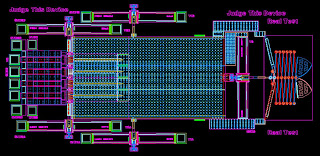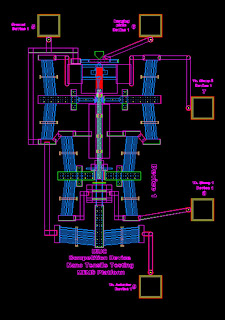MEMS student design contest winners announced by Sandia, Oklahoma and Illinois universities earn top micro design honors
 | ALBUQUERQUE, N.M. — Two winners of the third annual University Alliance competition for student microelectromechanical systems (MEMS) designs have been announced by Sandia National Laboratories, |
The novel design category was won by a team from the University of Oklahoma, which wrested first place from perennial winner Texas Tech with a micro device impressively named Parvissimus bracchius, for “smallest arm.”
A second category, new this year, called for a micro design that would reliably inspect nanoscale phenomena. This was won by the University of Illinois at Urbana-Champaign (UIUC).
 | “This competition is an opportunity for universities around the country to participate in an experience that incorporates all the intricate details of design, analysis, and fabrication of complex MEMS devices,” says Mark Platzbecker, technical team lead in Sandia’s MEMS Core Technologies Dept. High Resolution Image. Sandia is a National Nuclear Security Administration laboratory. |
“We wanted a 3-D structure with power and motion at the top,” student team leader Zach Butler explained to an audience of Sandia microdesigners. “We wanted a 3-D microrobot active above the chip and off the chip’s sides to grab theoretical microfruit off a low-hanging tree.”
The tool design shows a device with the ability to extend like an accordion or a micro automobile jack at the top.
The flat device, when heated, can rise one millimeter to a vertical position, with power available for actuators to perform tasks above the substrate through an extended arm reaching several hundred microns higher. Several tools for the extended arm are being investigated.
The device, said Butler, could make in vitro fertilization more efficient and provide less invasive biopsy procedures.
Kinematic simulations are in progress, he said.
In addition to Butler, other students on the team were Samuel Camp, Joseph Dingeldein, Andrew Mann, Stephen Thompson, and Andrea Watt.
The UIUC team was led by student Mohammad Naraghi under the direction of Professor Ioannis Chasiotis.
The UIUC device featured a mechanical testing platform capable of generating tens of micronewtons of force on highly deformable nanofibers, with a total displacement of 100 micrometers measurable by an integrated folded leaf spring-loaded cell.
Fabrication of the designs by winners and honorable-mention finishers are among the incentives offered by Sandia for schools to join and participate in the University Alliance. Each winning school also will receive a selection of their MEMS fabricated parts for use in their curriculum.
Seven participants in the Alliance, now 17 members strong, chose to enter this year’s competitions.
“The Sandia University Alliance is steadily growing,” said Tom Zipperian, Sandia senior manager for MESA microfabrication. “We expect to have 20 members by next year’s competition.”
For more information regarding the contest or becoming a member of the University Alliance, contact Stephanie Johnson at srjohns@sandia.gov
More contest information can be found at mems.sandia.gov/ua/contest
Sandia is a multiprogram laboratory operated by Sandia Corporation, a Lockheed Martin company, for the U.S. Department of Energy’s National Nuclear Security Administration. Sandia has major R&D responsibilities in national security, energy and environmental technologies, and economic competitiveness.
Sandia news media contact: Neal Singer, nsinger@sandia.gov, (505) 845-7078
Contact: Neal Singer nsinger@sandia.gov 505-845-7078 DOE/Sandia National Laboratories
Technorati Tags: nanofibers or Nanoscientists and Nano or Nanotechnology and nanoparticles or Nanotech and nanotubes or nanochemistry and nanoscale or Sandia National Laboratories or microelectromechanical systems and MEMS or Parvissimus bracchius and Nanotechnology Today or Public Domain Clip Art and Republican National Convention Blog














No comments:
Post a Comment